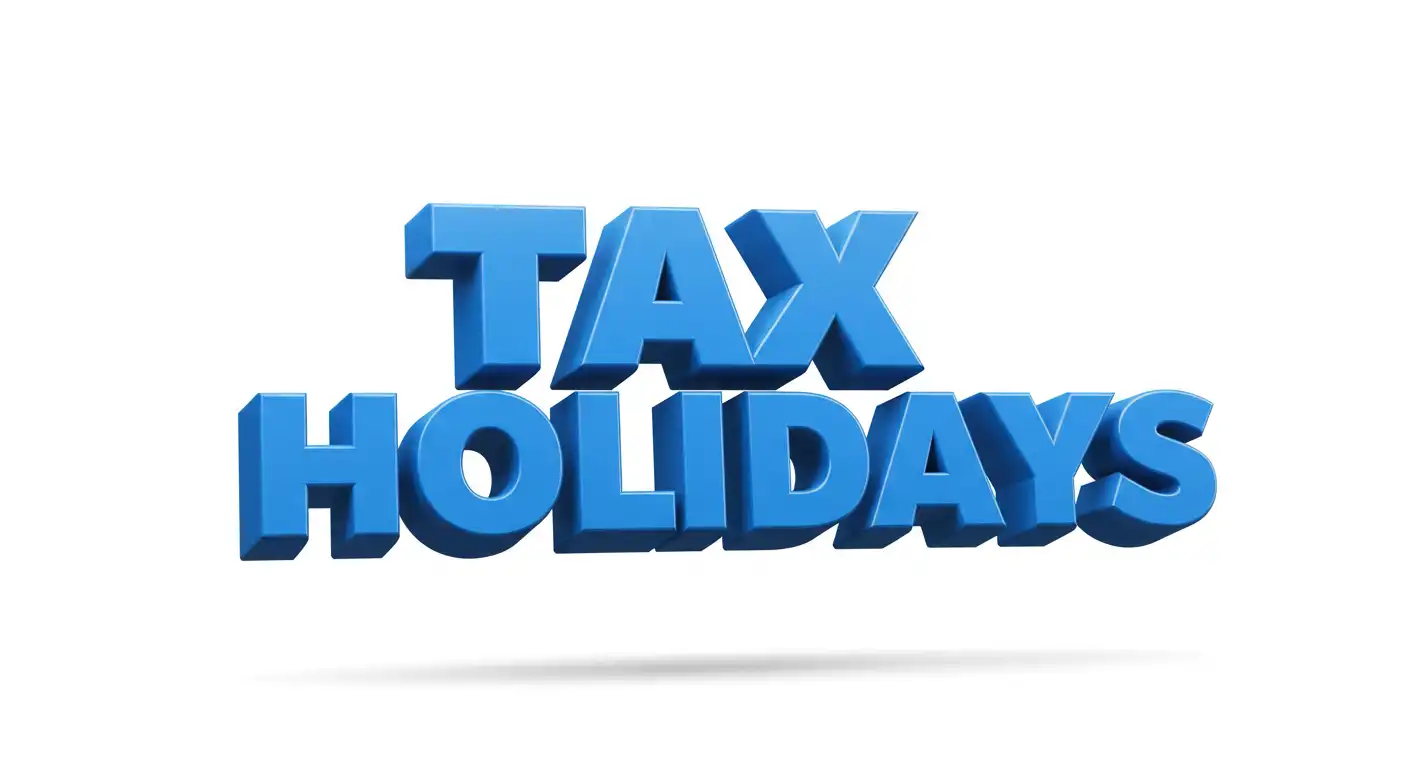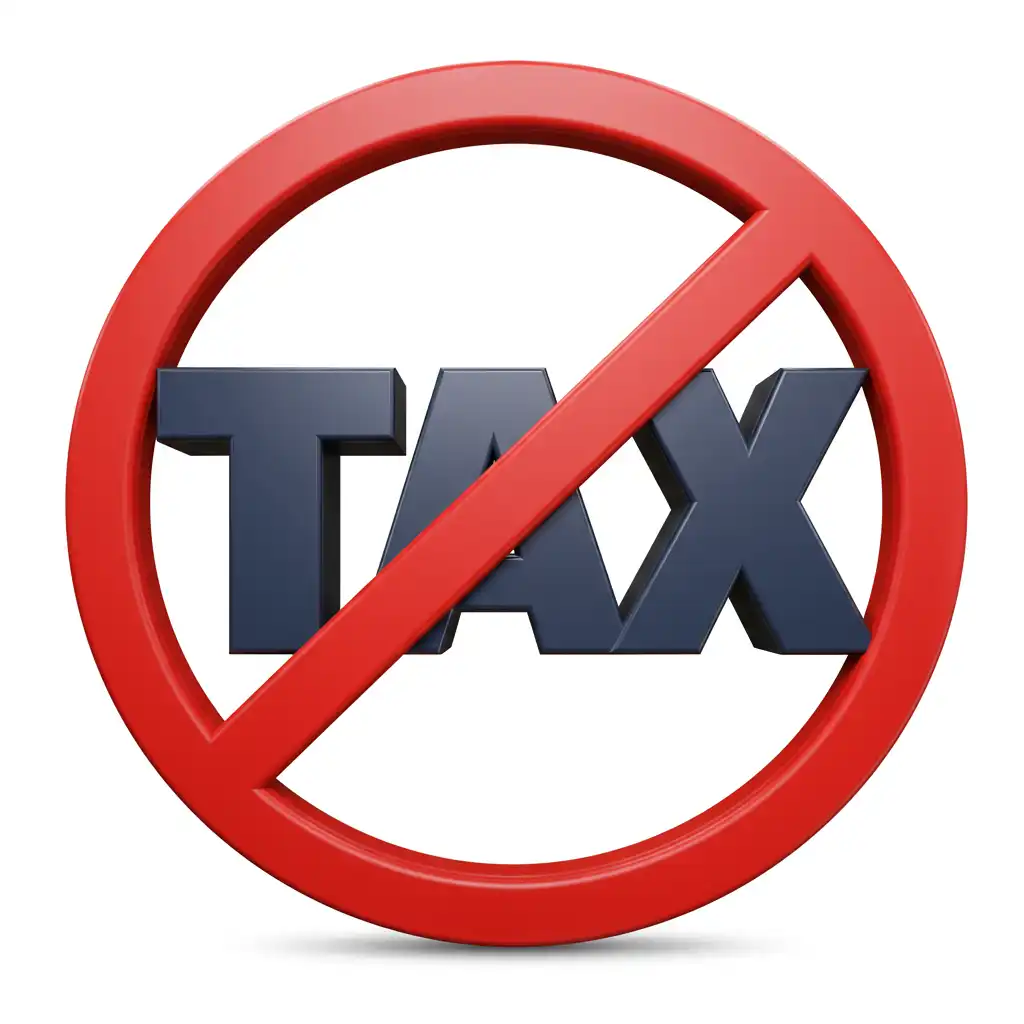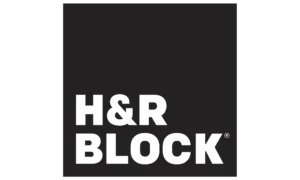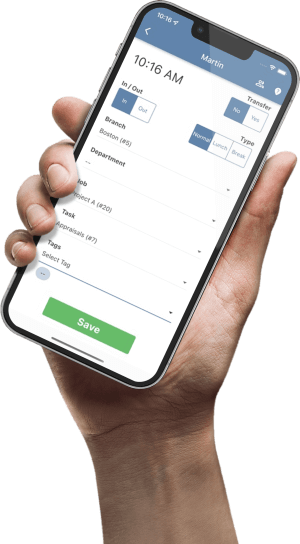US Sales Tax Holiday Calculator: 2025
US State Sales Tax Holiday Calculator
Please select a state to view available sales tax holiday events and their complete details.
Savings Breakdown
Table of US State Sales Tax Holidays: 2025
| State | Days | Items Included / Max Cost | First Year | 2025 Dates |
|---|---|---|---|---|
| Alabama | 3 | Back-to-School: Clothing ($100), Computers ($750), School Supplies ($50), Books ($30) | 2006 | July 18–20 |
| Alabama | 3 | Severe Weather Prep: Generators & Cords ($1,000), Supplies ($60) | 2012 | Feb 21–23 |
| Alaska | 152 | All Retail Sales in Skagway (no caps) | 2023 | Oct 1, 2024 – Mar 31, 2025 |
| Arizona | — | No Sales Tax Holiday in 2025 | — | — |
| Arkansas | 2 | Back-to-School: Clothing ($100), Accessories ($50), School & Art Supplies, Electronics | 2011 | Aug 2–3 |
| Connecticut | 7 | Clothing & Footwear up to $300 | 2001 | Aug 16–22 |
| Florida | 28 | Disaster Supplies ($10–$3,000) | 2022 | Jun 7–20 & Aug 23–Sep 5 |
| Florida | 31 | Freedom Month: Performances, Recreation Supplies ($25–$50) | 2021 | Jul 1–31 |
| Florida | 14 | Back-to-School: Supplies ($50), Clothing ($100), Computers ($1,500) | 2007 | Jul 28 – Aug 10 |
| Florida | 7 | Tool Time: Tools & Equipment | 2022 | Aug 31 – Sep 6 |
| Iowa | 2 | Clothing & Footwear up to $100 | 2000 | Aug 1–2 |
| Maryland | 7 | Back-to-School: Supplies | 2010 | Aug 9–15 |
| Maryland | 3 | Energy Star Appliances | 2011 | Feb 14–16 |
| Massachusetts | 2 | Most Retail Items up to $2,500 | 2004 | TBA (August) |
| Mississippi | 3 | Back-to-School: Clothing, Footwear, Supplies under $100 | 2009 | TBA |
| Mississippi | 3 | Hunting Gear: Archery, Accessories, Hearing Protection | 2014 | TBA |
| Missouri | 7 | Energy Star Appliances up to $1,500 | 2009 | TBA (April) |
| Missouri | — | Back-to-School: Supplies ($50), Clothing ($100), Computers ($3,500) | 2004 | TBA (April) |
| New Mexico | 3 | Back-to-School: Supplies ($30), Clothing ($100), Computers ($1,000) | 2005 | TBA |
| New Mexico | 1 | Small Business Saturday: Retail Items | 2023 | TBA |
| Ohio | 3 | All Items under $500 (some exceptions) | 2015 | First Weekend of August |
| Oklahoma | 3 | Clothing & Footwear under $100 | 2007 | Aug 1–3 |
| South Carolina | 3 | Clothing, Accessories, School Supplies, Computers, Software | 2000 | Aug 1–3 |
| Tennessee | 3 | Clothing, School Supplies, Computers | 2006 | Jul 25–27 |
| Texas | 3 | Back-to-School: Supplies, Clothing, Footwear, Backpacks | 1999 | Aug 8–10 |
| Texas | 3 | Energy Star: A/C ($6,000), Fridges ($2,000), Lights, Washers | 2008 | May 24–26 |
| Texas | 3 | Emergency Prep: Generators ($3,000), Supplies ($75–$300) | 2016 | Apr 26–28 |
| Texas | 3 | Water-Saving: Irrigation gear, Mulch, Soaker hoses | — | May 24–26 |
| Virginia | 3 | School, Emergency Prep, Energy Star & WaterSense Items | 2006 | Aug 1–3 |
| West Virginia | 4 | Clothing ($125), Computers ($500), Supplies ($50), Sports Equipment ($150) | 2021 | Aug 1–4 |
Found our Free US State Sales Tax Holiday Calculator useful? Bookmark and share it.

What Are Sales Tax Holidays?
At their core, sales tax holidays are temporary exemptions from state-level sales tax, and in some cases, local sales taxes, applied to a predefined list of consumer goods. These periods are established through state legislation, meaning their existence, duration, and parameters are dictated by law.
The legislative basis for these holidays can differ, impacting their predictability for consumers and retailers. Some holidays are designated as “annual” or recurring events, often tied to specific dates or formulas within the state statute (e.g., the first weekend of August). This structure provides a higher degree of certainty from year to year. Conversely, other holidays are “non-annual,” requiring specific legislative action and approval each year. These non-annual holidays, frequently observed in states like Florida, introduce an element of uncertainty, as their occurrence and details are contingent upon the annual legislative and budgetary process. This distinction influences planning, as consumers and businesses may not have confirmation of non-annual holidays until relatively close to the potential dates.
Furthermore, the specific rules governing participation and application can vary. For instance, while state sales tax exemption might be mandatory for qualifying items, the inclusion of local sales taxes (city, county) often depends on additional state provisions or separate local government ordinances. Therefore, a thorough understanding of the specific regulations within each participating state is crucial for accurately determining the scope of the tax relief.
Common Types of Tax Holidays You'll See in 2025
The landscape of sales tax holidays in 2025 features several recurring themes, reflecting common policy goals across various states.
Back-to-School Savings
This category represents the most widespread type of sales tax holiday. These events are typically concentrated in late July and August, coinciding with families’ preparations for the upcoming academic year. The primary aim is to alleviate the financial burden associated with purchasing necessary school items.
Eligible merchandise commonly includes:
- Clothing and footwear, often subject to a per-item price cap.
- Basic school supplies such as notebooks, pens, pencils, and binders.
- Backpacks.
- In many participating states, computers, certain computer accessories, and sometimes software also qualify for exemption, albeit often with higher price thresholds than clothing or supplies.
States anticipated to hold Back-to-School holidays in 2025 include Alabama, Arkansas, Connecticut, Florida (TBA), Iowa, Maryland, Mississippi, Missouri, New Mexico, Ohio (TBD Scope), Oklahoma, South Carolina, Tennessee, Texas, Virginia, and West Virginia.
Energy Efficiency Incentives (Energy Star)
Several states utilize sales tax holidays to encourage the adoption of energy-efficient appliances, typically those bearing the ENERGY STAR® certification. The policy objective is twofold: promoting broader energy conservation and potentially helping consumers reduce their long-term utility expenses.
Commonly eligible items include:
- ENERGY STAR® certified major appliances like air conditioners, refrigerators, clothes washers and dryers, dishwashers, water heaters, furnaces, and heat pumps.
- Smaller qualifying items such as dehumidifiers, programmable thermostats, and specific types of energy-efficient light bulbs (LEDs, CFLs).
States with scheduled Energy Star or similar holidays in 2025 include Maryland (February), Missouri (April), and Texas (May). Virginia also includes certain Energy Star and WaterSense™ products within its combined August holiday. Price caps can apply, varying by state and appliance type (e.g., Missouri imposes a $1,500 limit per appliance , while Texas has specific limits like $6,000 for air conditioners and $2,000 for refrigerators ).
Preparing for the Unexpected (Disaster/Severe Weather Preparedness)
Recognizing the importance of citizen preparedness during emergencies, some states offer tax holidays focused on relevant supplies. These events aim to encourage residents to acquire essential items needed to cope with events like hurricanes, tornadoes, floods, or extended power outages, potentially lessening the immediate strain on public emergency resources.
Typical qualifying items encompass:
- Portable generators (often with a high price threshold).
- Common preparedness supplies like batteries, battery-powered radios and flashlights, first-aid kits, tarps, plastic sheeting, coolers, manual can openers, and fuel containers.
- Safety equipment such as smoke detectors, carbon monoxide detectors, and fire extinguishers.
- In some coastal or storm-prone states, items like hurricane shutters or emergency ladders may also qualify.
States offering these holidays in 2025 include Alabama (February), Texas (April), and potentially Florida (dates TBA, but historically offered) and Puerto Rico (dates TBA). Virginia incorporates emergency preparedness items into its combined August holiday. Price caps vary significantly, often with a higher limit for generators (e.g., $1,000 in Alabama , under $3,000 in Texas ) and lower limits for other supplies (e.g., $60 in Alabama , under $75 or $300 in Texas depending on the item ).
The scheduling of these holidays often appears strategically aligned with regional weather patterns. For example, Alabama’s February event precedes the typical spring severe weather season in the Southeast. Similarly, Texas holds its holiday in late April. Florida and Puerto Rico typically schedule theirs before or during the Atlantic hurricane season (June-November). This timing suggests an effort to maximize the holiday’s impact by prompting preparedness actions when the associated risks are more top-of-mind for residents.
Other Specialized Holidays
Beyond the common categories, several states implement tax holidays tailored to specific industries, activities, or constituent groups, demonstrating a more targeted use of this policy tool. Examples include:
- Second Amendment Holidays: Louisiana (September) and Mississippi (dates TBA) offer tax exemptions on firearms, ammunition, and certain hunting supplies. These holidays can have complexities, such as lists of specific eligible/ineligible items or the possibility of local jurisdictions opting out. Tennessee also supports related policy through a permanent sales tax exemption for gun safes.
- General Tangible Personal Property: Massachusetts (dates TBA, typically August) provides a broad exemption for most retail items intended for personal use, up to a high threshold of $2,500 per item. Ohio’s 2024 holiday was temporarily expanded to cover general tangible personal property under $500, contingent on state budget surplus; its 2025 status and scope remain to be determined but could follow a similar pattern.
- Tools/Skilled Trades: Florida has previously offered a “Tool Time” holiday (2025 dates TBA) exempting certain tools and equipment commonly used by skilled trade workers.
- Freedom Month/Week: Florida (typically July) exempts sales tax on admissions to various events, plus a range of recreational, camping, fishing, and outdoor supplies.
- Small Business Saturday: New Mexico offers a Gross Receipts Tax deduction (rather than a direct consumer exemption) for qualifying small businesses on sales of eligible items on the Saturday after Thanksgiving (2025 dates TBA).
- National Guard Member Holiday: Nevada provides a tax-free period (late October/early November, 2025 dates TBA) specifically for purchases made by active members of the Nevada National Guard and their dependents.
The existence of these diverse, specialized holidays suggests that states are increasingly viewing tax holidays not merely as broad economic stimulants but as precise instruments to advance specific policy agendas, support designated industries (like firearms/hunting or skilled trades), encourage particular activities (recreation), or provide benefits to targeted groups (small businesses, National Guard members). This marks a potential evolution from the original broad-based relief concept toward more finely tuned applications of temporary tax exemptions.


Key Things to Know Before You Shop
To effectively leverage sales tax holidays, consumers should be aware of several critical factors that apply across most participating states.
Price Caps and Thresholds are Crucial
A fundamental aspect of nearly all sales tax holidays is the application of price caps or thresholds. The tax exemption typically applies only to individual items priced at or below a specified limit. Crucially, if an item’s price exceeds the threshold, the exemption is usually lost entirely for that item; the entire purchase price becomes subject to sales tax. For example, purchasing a $110 shirt in a state with a $100 clothing limit generally means sales tax is due on the full $110, not just the amount exceeding the cap.
These price limits exhibit significant variation from state to state and category to category. Clothing thresholds in 2025, for instance, range from potentially $75 (Ohio, depending on final rules) up to $125 (West Virginia), with many states setting the limit at $100. Computer limits show even wider disparities, from $500 (West Virginia laptops/tablets) to $750 (Alabama), $1,000 (New Mexico), and $1,500 (Florida, Missouri, Tennessee), while South Carolina notably lacks a price cap for computers during its holiday. Massachusetts stands out with its high $2,500 threshold for general merchandise.
This variability in price caps directly influences the practical value of the holiday for consumers with different purchasing needs and budgets. States implementing higher thresholds allow for potentially greater savings and accommodate the purchase of higher-quality or more feature-rich items (e.g., more powerful computers, higher-end clothing). Conversely, lower caps may restrict the benefit primarily to basic or entry-level purchases. The effective tax relief realized by a consumer is therefore heavily dependent on both their intended purchases and the specific thresholds established by the state.
Eligible vs. Non-Eligible Items: Read the Fine Print
Eligibility for tax exemption is strictly defined by category and often involves detailed specifications. Consumers should not assume broad categories cover all related items. For example:
- “Clothing” might explicitly exclude accessories like belts or jewelry, or specialized items like athletic uniforms or protective gear. Iowa’s holiday specifically excludes clothing accessories. Maryland taxes the portion of a backpack’s price over $40.
- “School supplies” eligibility may be based on detailed lists provided by the state, potentially excluding certain art supplies or instructional materials.
- “Computers” might cover the central processing unit and standard peripherals but exclude gaming consoles, smartphones, or certain software unless specified.
- Category definitions can differ significantly. South Carolina, for example, includes certain bed and bath items in its Back-to-School holiday, a category not typically covered elsewhere. Alabama provides highly specific lists for qualifying severe weather preparedness items.
Given these complexities, relying solely on advertisements is insufficient. Consumers are strongly advised to consult the official guidance and detailed item lists published by the respective state’s Department of Revenue or Taxation website prior to shopping.
Online Shopping, Layaways, and Other Rules
Several logistical factors also influence how sales tax holidays apply:
- Online Sales: The applicability of the exemption to online purchases often depends on whether the seller is registered to collect sales tax in the buyer’s state and the timing of the transaction (order placement, payment, and sometimes shipment date relative to the holiday period). Texas explicitly confirms that qualifying items purchased online from sellers doing business in Texas are eligible during its holiday. While many states include online sales, specific rules can vary, making it essential to check state guidelines.
- Layaway Sales: Rules for items purchased on layaway differ by state. Often, eligibility hinges on the final payment being made and the item being delivered to the customer during the official sales tax holiday period. Pre-existing layaways where final payment occurs during the holiday may qualify.
- Business Purchases: Sales tax holidays are generally intended for personal, non-commercial use. Purchases made by businesses or for business purposes are typically excluded from the exemption.
- Local Taxes: A critical point is that state-level sales tax holidays do not automatically exempt items from local sales taxes (imposed by cities, counties, or special districts). Exemption from local taxes depends on state law or specific ordinances passed by local governments. Some states, like Arkansas and Iowa, mandate that the holiday applies to both state and local taxes. In other states, like Alabama, local participation is optional. This variance can significantly impact the total savings realized by the consumer.
- Retailer Participation: For state sales tax, retailer participation is generally mandatory for qualifying items sold during the holiday period. Retailers are typically prohibited from charging state sales tax on legally exempt items and cannot advertise that they will absorb the tax on non-qualifying items as a substitute.
The intricate nature of these rules—covering online transactions, local tax applicability, precise item definitions, and price thresholds—underscores that consumers need to engage in proactive research beyond simply knowing the holiday dates. A clear understanding of these nuances is necessary to avoid unexpected tax charges and fully capitalize on potential savings opportunities.
Visualizing the 2025 Tax Holiday Landscape
Visual representations can help illustrate key patterns in the timing and scope of sales tax holidays scheduled for 2025. The data below is structured to facilitate the creation of such visualizations.
When Do Tax Holidays Occur in 2025? (Data for Timeline Chart)
This data shows the distribution of sales tax holidays throughout the calendar year. A timeline chart based on this data would visually highlight the concentration of Back-to-School holidays in late summer but also reveal savings opportunities available in other months for different categories like energy efficiency or emergency preparedness. This allows for strategic planning beyond just the traditional August shopping period.
Data for 2025 Sales Tax Holiday Timeline Chart:
- State: Puerto Rico, Type: Back-to-School, Start: 2025-01-10, End: 2025-01-11
- State: Maryland, Type: Energy Star, Start: 2025-02-15, End: 2025-02-17
- State: Alabama, Type: Weather Prep, Start: 2025-02-21, End: 2025-02-23
- State: Missouri, Type: Energy Star, Start: 2025-04-19, End: 2025-04-25
- State: Texas, Type: Emergency Prep, Start: 2025-04-26, End: 2025-04-28
- State: Puerto Rico, Type: Hurricane Prep, Start: 2025-05-24 (TBA), End: 2025-05-25 (TBA)
- State: Texas, Type: Energy Star, Start: 2025-05-24, End: 2025-05-26
- State: Florida, Type: Disaster Prep, Start: 2025-06-07 (TBA), End: 2025-06-20 (TBA)
- State: Florida, Type: Freedom Month, Start: 2025-07-01 (Likely), End: 2025-07-31 (Likely)
- State: Mississippi, Type: Back-to-School, Start: 2025-07-11, End: 2025-07-13
- State: Puerto Rico, Type: Back-to-School, Start: 2025-07-12, End: 2025-07-13
- State: Alabama, Type: Back-to-School, Start: 2025-07-18, End: 2025-07-20
- State: Tennessee, Type: Back-to-School, Start: 2025-07-25, End: 2025-07-27
- State: Florida, Type: Back-to-School, Start: 2025-07-28 (TBA), End: 2025-08-10 (TBA)
- State: Ohio, Type: Sales Tax Holiday, Start: 2025-07-29 (TBD), End: 2025-08-07 (TBD)
- State: Iowa, Type: Back-to-School, Start: 2025-08-01, End: 2025-08-02
- State: Missouri, Type: Back-to-School, Start: 2025-08-01, End: 2025-08-03
- State: New Mexico, Type: Back-to-School, Start: 2025-08-01, End: 2025-08-03
- State: Oklahoma, Type: Back-to-School, Start: 2025-08-01, End: 2025-08-03
- State: South Carolina, Type: Back-to-School, Start: 2025-08-01, End: 2025-08-03
- State: Virginia, Type: Combined Holiday, Start: 2025-08-01, End: 2025-08-03
- State: West Virginia, Type: Back-to-School, Start: 2025-08-01, End: 2025-08-04
- State: Arkansas, Type: Back-to-School, Start: 2025-08-02, End: 2025-08-03
- State: Texas, Type: Back-to-School, Start: 2025-08-08, End: 2025-08-10
- State: Maryland, Type: Back-to-School, Start: 2025-08-10, End: 2025-08-16
- State: Massachusetts, Type: General Merchandise, Start: 2025-08-10 (TBA), End: 2025-08-11 (TBA)
- State: Connecticut, Type: Back-to-School, Start: 2025-08-17, End: 2025-08-23
- State: Florida, Type: Disaster Prep, Start: 2025-08-23 (TBA), End: 2025-09-05 (TBA)
- State: Florida, Type: Tool Time, Start: 2025-08-31 (TBA), End: 2025-09-06 (TBA)
- State: Mississippi, Type: Second Amendment, Start: 2025-08-29 (TBA), End: 2025-08-31 (TBA)
- State: Louisiana, Type: Second Amendment, Start: 2025-09-05 (Anticipated), End: 2025-09-07 (Anticipated)
- State: Nevada, Type: National Guard Members, Start: 2025-10-31, End: 2025-11-02
- State: New Mexico, Type: Small Business Sat., Start: 2025-11-29 (Likely/TBA), End: 2025-11-29 (Likely/TBA)
How Do Price Limits Compare? (Data for Bar Graph - Clothing/Computers)
This data set allows for a direct comparison of price thresholds for two commonly purchased categories: clothing and computers (where applicable). A bar graph generated from this data would visually demonstrate the significant differences in how states approach these exemptions. For example, it would highlight the relatively low thresholds in some states versus the higher limits or lack of limits in others, making the relative value proposition for purchasing these specific items clearer across different states.
Data for Price Limit Comparison Bar Graph (Clothing & Computers, 2025):
- State: Alabama, Category: Clothing, Limit: 100
- State: Arkansas, Category: Clothing, Limit: 99.99
- State: Connecticut, Category: Clothing, Limit: 99.99
- State: Florida, Category: Clothing, Limit: 100 (TBA)
- State: Iowa, Category: Clothing, Limit: 99.99
- State: Maryland, Category: Clothing, Limit: 100
- State: Mississippi, Category: Clothing, Limit: 99.99
- State: Missouri, Category: Clothing, Limit: 100
- State: New Mexico, Category: Clothing, Limit: 99.99
- State: Ohio, Category: Clothing, Limit: 75 (Potential/TBD)
- State: Oklahoma, Category: Clothing, Limit: 99.99
- State: South Carolina, Category: Clothing, Limit: -1
- State: Tennessee, Category: Clothing, Limit: 100
- State: Texas, Category: Clothing, Limit: 99.99
- State: Virginia, Category: Clothing, Limit: 100
- State: West Virginia, Category: Clothing, Limit: 125
- State: Alabama, Category: Computers, Limit: 750
- State: Florida, Category: Computers, Limit: 1500 (TBA)
- State: Missouri, Category: Computers, Limit: 1500
- State: New Mexico, Category: Computers, Limit: 1000
- State: South Carolina, Category: Computers, Limit: -1
- State: Tennessee, Category: Computers, Limit: 1500
- State: West Virginia, Category: Computers (Laptop/Tablet), Limit: 500
Note: Limit of -1 indicates no price cap applies to the category in that state's holiday. Computer category definitions may vary (e.g., peripherals included/excluded). Ohio limits are potential/TBD. Florida limits require confirmation.

Disclaimer: The content provided on this webpage is for informational purposes only and is not intended to be a substitute for professional advice. While we strive to ensure the accuracy and timeliness of the information presented here, the details may change over time or vary in different jurisdictions. Therefore, we do not guarantee the completeness, reliability, or absolute accuracy of this information. The information on this page should not be used as a basis for making legal, financial, or any other key decisions. We strongly advise consulting with a qualified professional or expert in the relevant field for specific advice, guidance, or services. By using this webpage, you acknowledge that the information is offered “as is” and that we are not liable for any errors, omissions, or inaccuracies in the content, nor for any actions taken based on the information provided. We shall not be held liable for any direct, indirect, incidental, consequential, or punitive damages arising out of your access to, use of, or reliance on any content on this page.
Trusted By
Trusted by 3.2M+ Employees: 21 Years of Service Across Startups to Fortune 500 Enterprises
Join our ever-growing community of satisfied customers today and experience the unparalleled benefits of TimeTrex.










Strength In Numbers
Join The Companies Already Benefiting From TimeTrex
Time To Clock-In
Start your 30-day free trial!
Experience the Ultimate Workforce Solution and Revolutionize Your Business Today
- Eliminate Errors
- Simple & Easy To Use
- Real-time Reporting

Saving businesses time and money through better workforce management since 2003.
Copyright © 2025 TimeTrex. All Rights Reserved.
